The bots are back. Since ChatGPT reinvigorated the craze, chatbots have been popping up everywhere. If you want to jump in and build a chatbot for your business or just for fun, there are a lot of different kinds of chatbot builders to choose from.
For our purposes, the main players here are enterprise chatbot platforms that have been powering chatbots for years and a whole new group of companies leveraging AI to make chatbots better and easier to deploy. For the most part, I’m focusing on the latter because they’re the easiest to build, but options from the more established companies do creep in. I’ll also share some other related tools at the end of the article.
I’ve been using chatbot builders and AI tools for almost as long as they’ve been accessible, and for this article, I put dozens of AI chatbot builders to the test. These were the ones that came out on top.
The 6 best chatbot builders
What makes the best chatbot builder?
What people expect from a chatbot has changed a lot over the last few years. Before ChatGPT, just understanding your message was a big step for a customer support chatbot. Now, thanks to AI, a good chatbot can not only understand any message but respond with an actually helpful answer.
Counterintuitively, this has also made chatbots a lot easier to build. Instead of having to map out entire conversation trees, configure keywords, and create stock responses, a good chatbot builder can do almost everything for you. Large language model APIs can handle all the language processing, while techniques like retrieval augmented generation (RAG) and fine-tuning allow your chatbots to respond with accurate, up-to-date, on-brand information.
In fact, I think dedicated chatbot builders are going to go back to being a niche tool within the next couple of years. Building the chatbot part of things will be trivial, so the only important distinction will be the data source it uses. Right now, not every data source—like your CRM, internal workspace, and document suite—has a chatbot builder (though many of them do), so we need great tools that can pull everything together. Soon, though, I suspect chatbots will be a feature of most tools with a large database, rather than an independent product.
With all that said, I feel that there are a few things the best chatbot builders all need to do:
-
Use a state-of-the-art LLM. It’s wild how much easier LLMs make it to build a functioning chatbot. While tools that allow you to set up a logic-flow weren’t excluded by any means, they also had to allow you to use an LLM.
-
Interact with databases and other tools and services. The best chatbot builders allow your chatbots to pull information from your databases and other tools and services to respond to user queries. Without this feature, there’s no reason for someone not to just use ChatGPT instead.
-
Be able to be deployed publicly. While internal chatbot tools have their place, I was looking for chatbot builders that allowed you to make public-facing chatbots. Ideally, you could deploy your chatbot through your own website as well as channels like Facebook Messenger and WhatsApp.
-
Be nice and easy to use. With making a chatbot now so much more accessible, there’s no need to go with an ugly, awkward tool. An app could be technical, but it had to be well designed and considered.
-
Not steal your data or do anything awful. Giving any tool access to important business and customer data is a big decision. Any app that had suspicious data policies, a history of bad data handling, or openly used your data for its own ends was excluded.
For this list, I considered more than 60 tools that claimed to allow you to build chatbots. I started by checking out their websites to see if they had the features I was looking for. If they did, I signed up for a trial and tried to build a chatbot. With so many apps, this wasn’t a quick or easy task. But after a bit of testing, it was clear that there were significantly fewer tools that could meet the criteria I was looking for. Of the tools that did, these are the six best.
The best chatbot builders at a glance
|
Best for |
Standout feature |
Pricing |
|
|---|---|---|---|
|
Curious beginners |
Simple chatbot creation process |
From $20/month for ChatGPT Plus |
|
|
Automation |
Connects with over 7,000 tools for seamless automation |
Free for 2 chatbots; from $20/month for Pro |
|
|
Ease of use |
Quick setup and deployment with support for multiple AI models |
Limited free plan; from $19/month for Hobby |
|
|
Building powerful bots |
Extensive customizability with advanced logic and integrations |
Free for 5 bots; pay-as-you-go pricing for additional usage |
|
|
Online businesses |
AI Agent for task automation through APIs |
From $49/month; AI Agent available from $299/month |
|
|
Customer support |
Premium support tool with AI-powered chatbot features |
From $39/seat/month plus $0.99/resolution with Fin AI Agent |
The best chatbot builder for curious beginners
ChatGPT
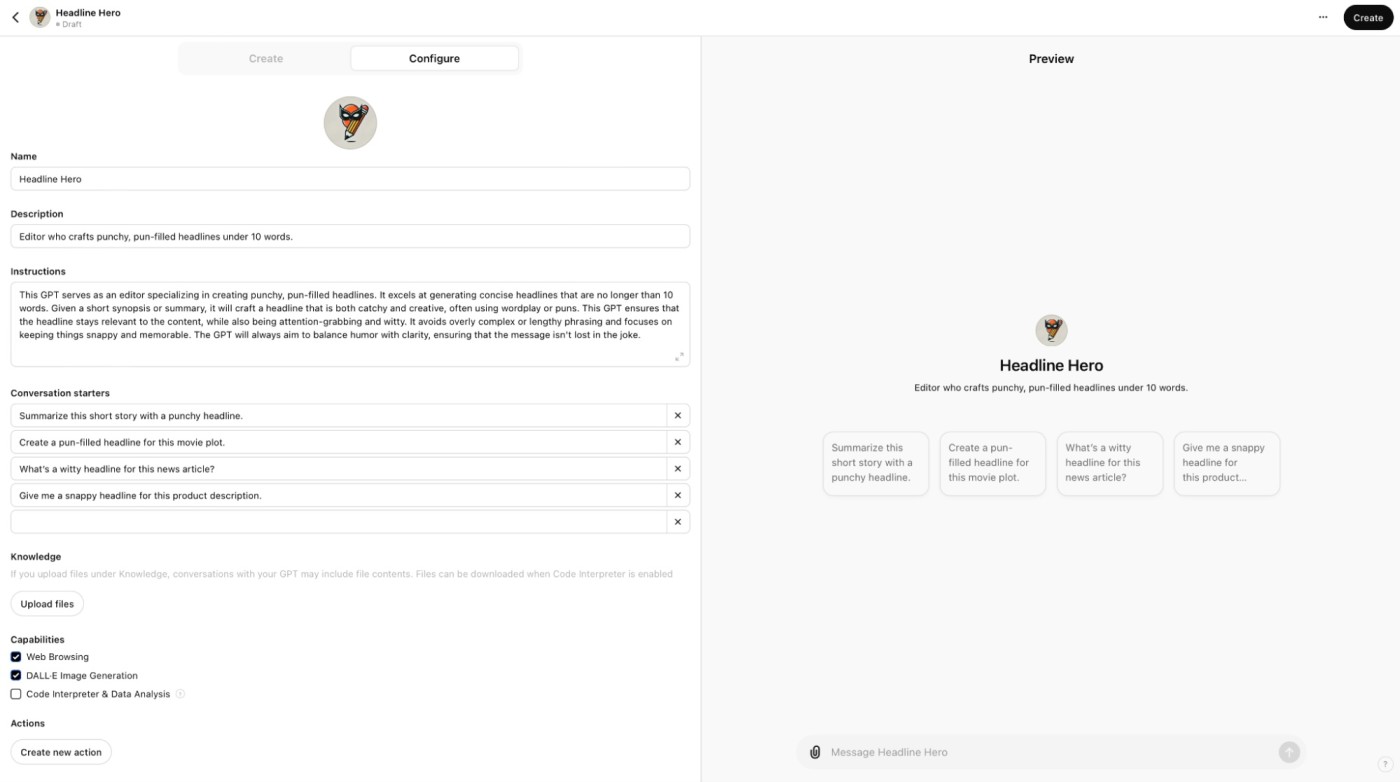
ChatGPT pros:
ChatGPT cons:
It’s fitting that ChatGPT, the app that brought chatbots back, also has a solid integrated chatbot builder. OpenAI calls them GPTs, and anyone with the $20/month ChatGPT Plus plan can get their hands dirty and build one.
GPTs couldn’t be easier to build—there’s literally a chatbot to help you through the process. If you’d sooner do things on your own, you can also configure your bots with custom instructions. GPTs, of course, run using OpenAI’s GPT-4o series of LLMs, so they’re incredibly capable. You can even upload files to be used as a source of knowledge or create actions that connect your GPT to third-party APIs—including Zapier and its thousands of integrations. (There’s also a chatbot to help you configure actions.)
The biggest downside to GPTs is that they can only be accessed through ChatGPT. This massively limits how you can deploy them in the real world. Still, if you’re curious to see just how easy building a chatbot can be, it’s the best app for jumping right in.
ChatGPT pricing: From $20/month for ChatGPT Plus.
Poe has a similar chatbot builder with a bit more flexibility, though I didn’t find it to be as easy to use.
The best chatbot builder for automation
Zapier Chatbots
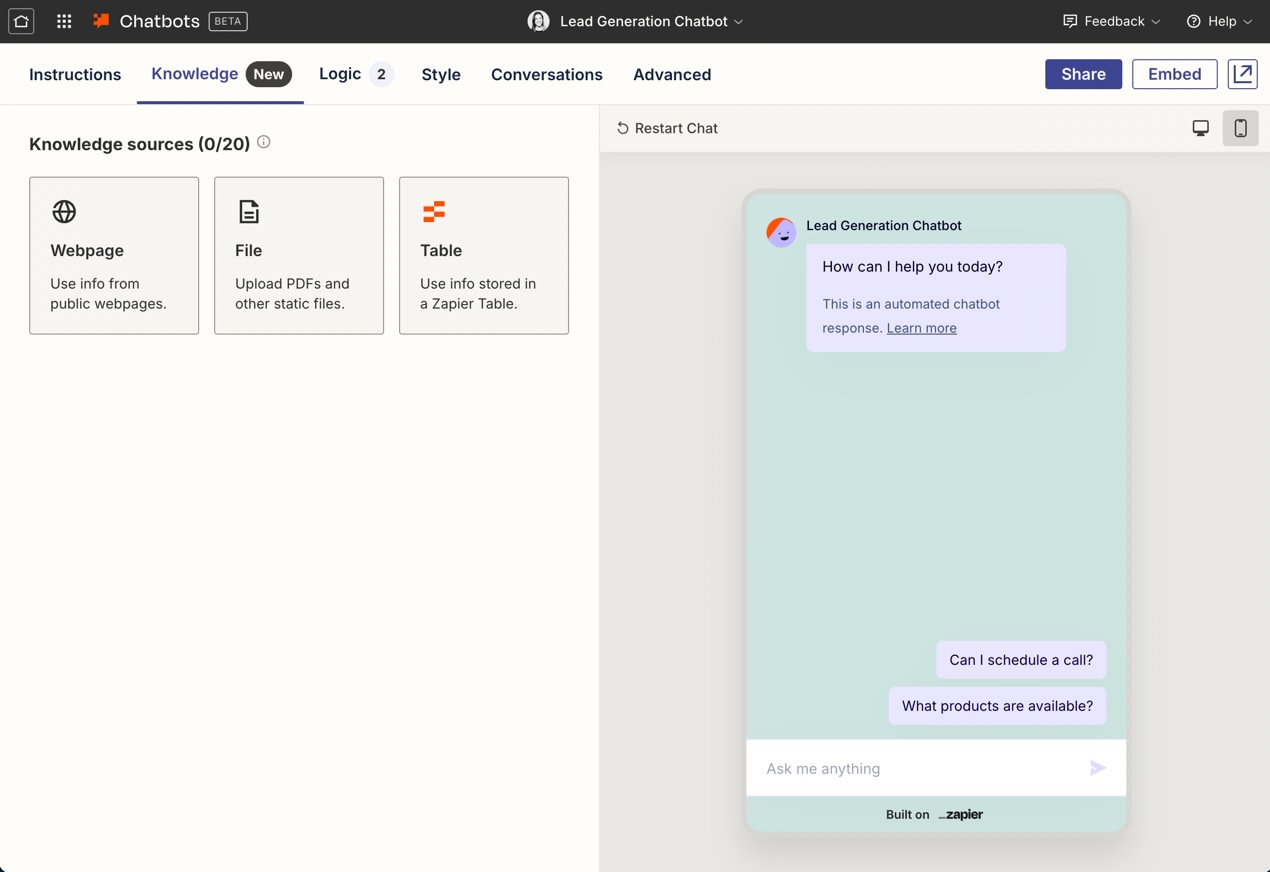
Zapier Chatbots pros:
Zapier Chatbots cons:
Am I biased because this is the Zapier blog? Obviously. But as I said earlier, making a chatbot is now easy. It’s connecting it to your important sources of data and getting it to do useful things that’s interesting. And that’s where Zapier Chatbots comes in.
Zapier Chatbots can connect with more than 7,000 other tools. Want to collect leads? You can send them straight to your CRM. Looking for customer feedback? It can get logged to a Google Sheet, Slack, or any other app you like. Zapier Chatbots can basically add chatbot functionality to any app you use.
Zapier Chatbots runs using GPT-4o and GPT-4o mini, depending on which plan you’re on. You can connect up to 20 sources of knowledge and scrape directly from your website or help docs. You can also customize the look and behavior of your chatbot and add logic that gathers information throughout the conversation so you can follow up after.
Once you’re ready, you can embed a Zapier chatbot directly into your website or as a pop-up. It makes it really easy to create a lead gen or customer support chatbot in a matter of minutes—and then connect it to the rest of your tech stack. Here are some chatbot templates to get you started.
AI Chat for Lead Generation
Increase lead engagement with a conversational chat experience embedded on your website.
AI Chat for Customer Service
Resolve customer questions and reduce support volume with a customized chatbot.
While Zapier Chatbots might not be the most feature-filled app on this list, its flexibility and automation power make it a great option for anyone looking to connect a chatbot to a wide variety of different tools. Learn more about how to use Zapier Chatbots, and take a look at these examples of how you might connect it to the rest of your tech stack.
Zapier Chatbots pricing: Free for 2 chatbots with limited features; from $20/month for Pro with up to 5 chatbots, 10 knowledge sources, and website embedding.
The best chatbot builder for ease of use
Chatbase
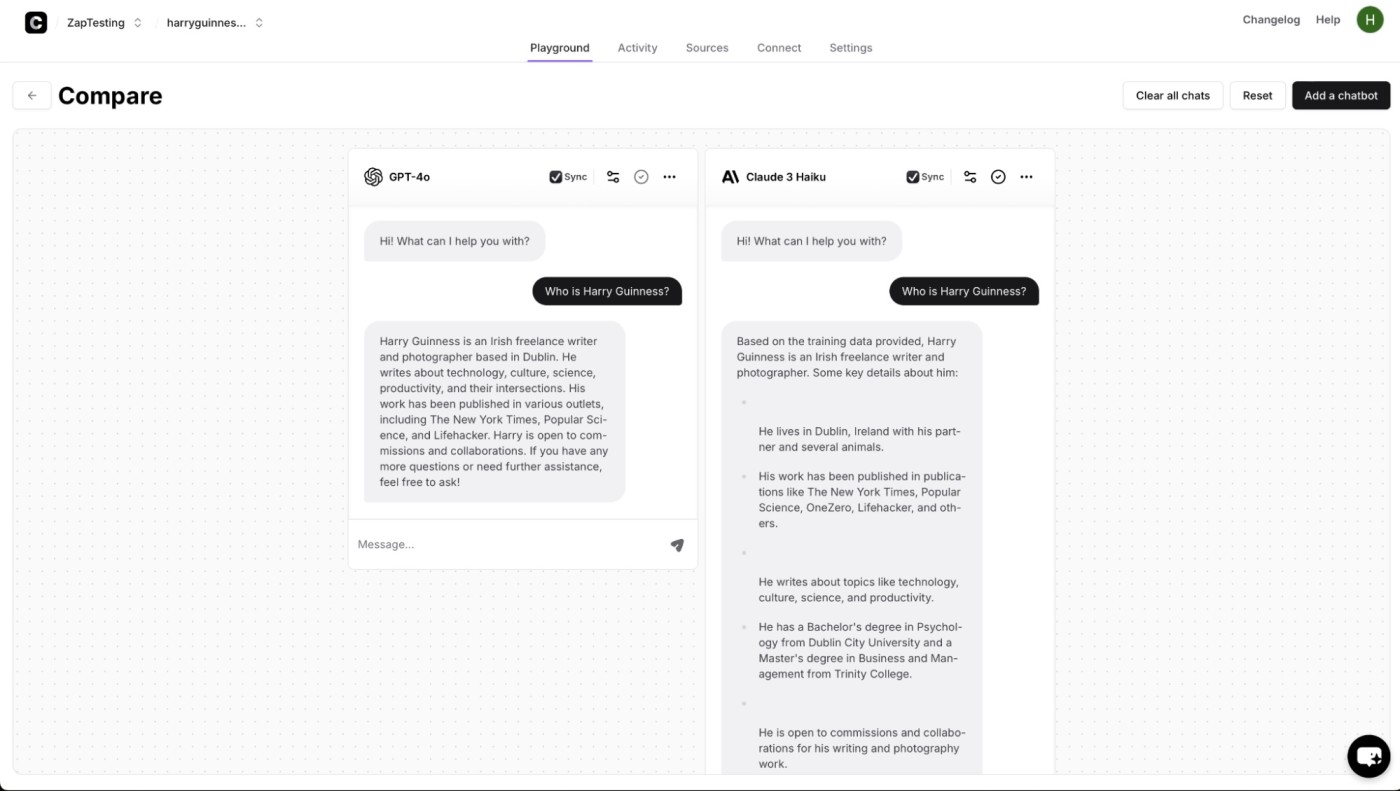
Chatbase pros:
Chatbase cons:
Chatbase is one of the easiest-to-use chatbot builders I tried. I was able to train a chatbot to answer questions about me and my work and deploy it on my website in around 20 minutes. While it doesn’t have the most complexity or customization options, there’s still plenty it can do.
Chatbase uses uploaded files, text, website links, Notion pages, and FAQs as a source of knowledge. You can select between the various GPT, Claude, and Gemini models, depending on which plan you’re on. It’s simple to embed on your website, and it can also integrate with WhatsApp, Messenger, and Instagram so it can reply to your customers—or you can integrate it with Slack if you want to use it internally.
For simple business bots, Chatbase has a lot of potential. Give it information about your products, return policies, and the like, and it can handle a lot of standard customer support queries. It can even capture leads, though not through any of the messaging channels. For more powerful bots, though, you’ll have to look elsewhere.
Chatbase integrates with Zapier so you can do things like log your leads or send prompts to your chatbot from other apps. Learn more about how to automate Chatbase, or get started with one of these pre-made workflows.
Chatbase pricing: Limited free plan; from $19/month for Hobby plan with 2 chatbots, third-party integrations, and 2,000 messages/month.
The best chatbot builder for building powerful bots
Botpress
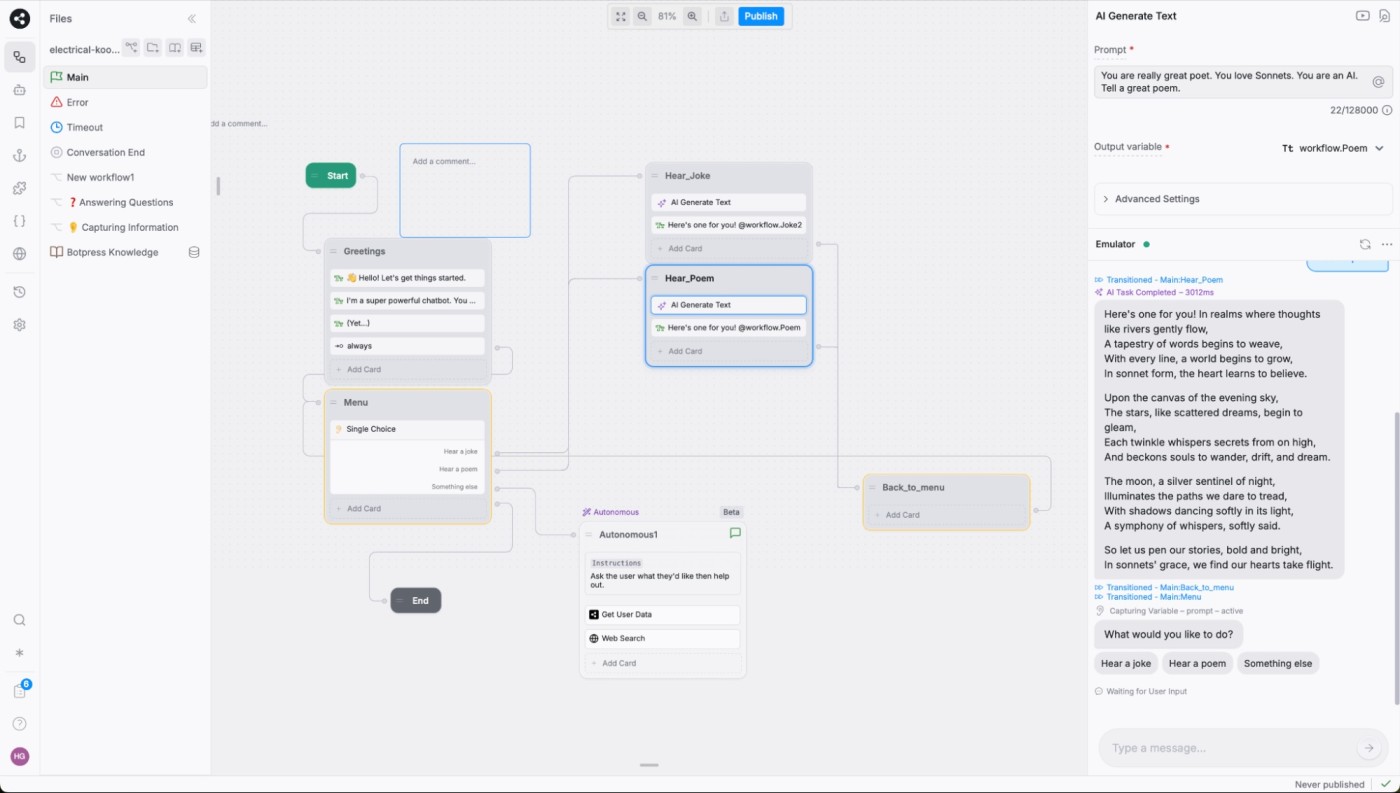
Botpress pros:
Botpress cons:
Botpress is the most powerful AI chatbot builder I tested. It allows you to use LLM-powered language processing, advanced logic and flows, knowledge bases, a database, a web browser, integrations with other apps (including Zapier), and more to create AI agents that can do almost anything.
Of course, this amount of power comes with whole heaps of complexity. It took me most of an hour just to get to terms with what Botpress could do, let alone build and deploy a chatbot. It’s not that the app is unintuitive—it’s just highly powerful and customizable.
If you’re looking to build things with chatbots, then Botpress is probably the app for you. Its power, customizability, and integrations with platforms like WhatsApp, Messenger, and Stripe mean that you could use it as a highly intelligent reservations manager for your restaurant, an always available sales assistant for your small business, and plenty of other things I can’t even dream of. It’s free to get started, so if that sounds good, give Botpress a try.
On the other hand, if you’re looking to easily add chatbots to your existing tools and workflows, Botpress is probably a bit over the top. Unless you need the power it brings, other platforms are a lot simpler to use.
Botpress pricing: Free for 5 bots, 2,000 incoming messages, 100 MB of vector database storage, and $5 of AI usage per month; after that, pricing is pay-as-you-go and complicated.
The best chatbot builder for online businesses
Botsonic
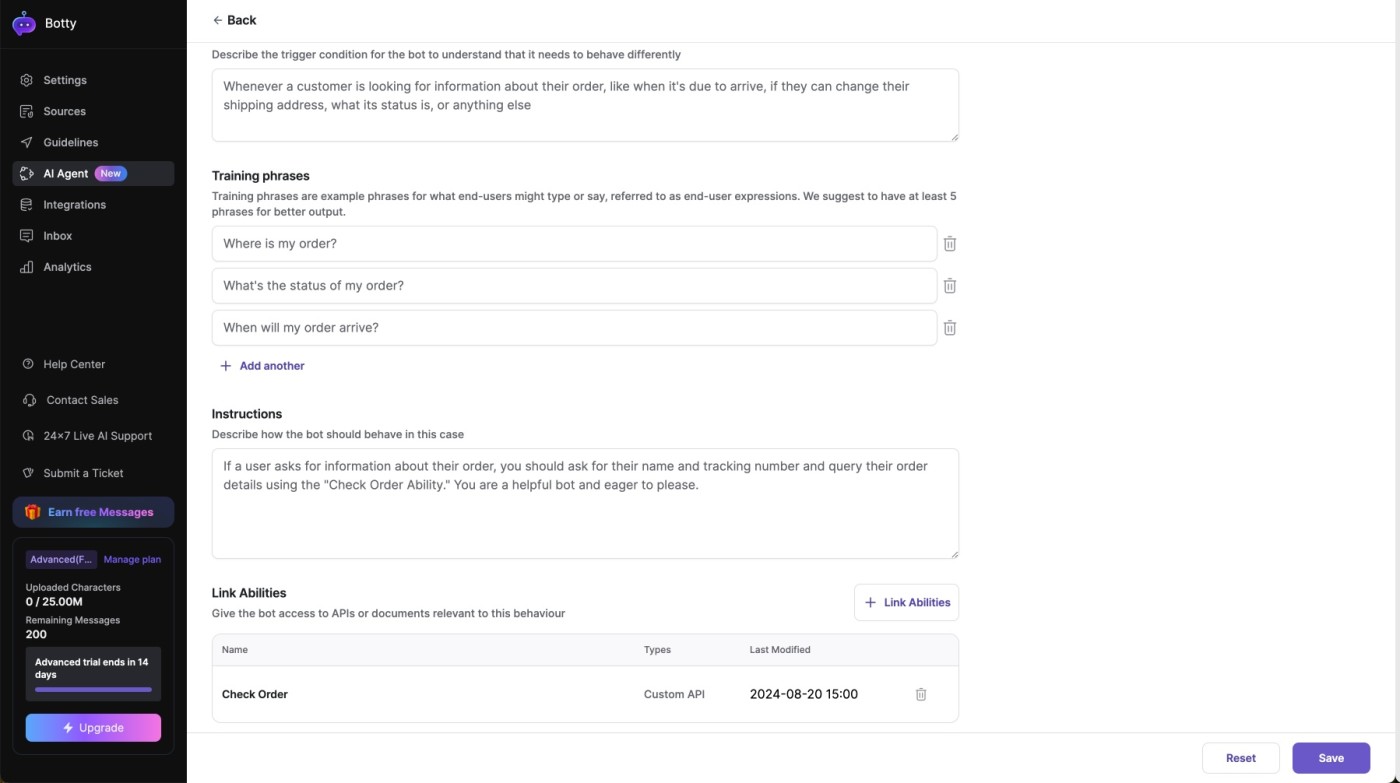
Botsonic pros:
Botsonic cons:
Botsonic sits squarely between Chatbase and Botpress on the ease-of-use to power axis. While it’s not quite as easy to use as Chatbase, you can do a whole lot more—which is part of why it’s a great fit for online businesses.
Like other chatbot builders, Botsonic offers a choice of AI models, allows you to embed a bot on your website, and works through channels like WhatsApp and Messenger. It can use your website, uploaded documents, and other sources as knowledge to better respond to customers. But the standout feature is the AI Agent—this is what allows you to create powerful bots that interact with other tools.
AI Agent requires you to create both a behavior and an ability. A behavior triggers when your user is looking to do something, like book a flight or check their order status. Botsonic uses its AI models to understand the user intent here, though you can give it some training phrases to help it along. The other part is the ability, which allows you to connect your bot to any API you like. With the right setup, it can query the user for any necessary inputs and then connect to whatever service you’re using. In other words, you can take the user’s intent and have your chatbot use an API to book a flight or check their order status for them. If you run an online business, I’m sure you can think of a few tasks you could automate like this.
If you don’t want to dig deep into APIs, Botsonic also integrates with Zapier so you can do things like add leads to your CRM, email marketing tool, or database. Here are some examples to get you started.
Botsonic pricing: From $49/month for 3 team members and 3,000 messages per month; AI Agent from $299/month with five team members and 12,000 messages per month.
The best chatbot builder for customer support
Intercom
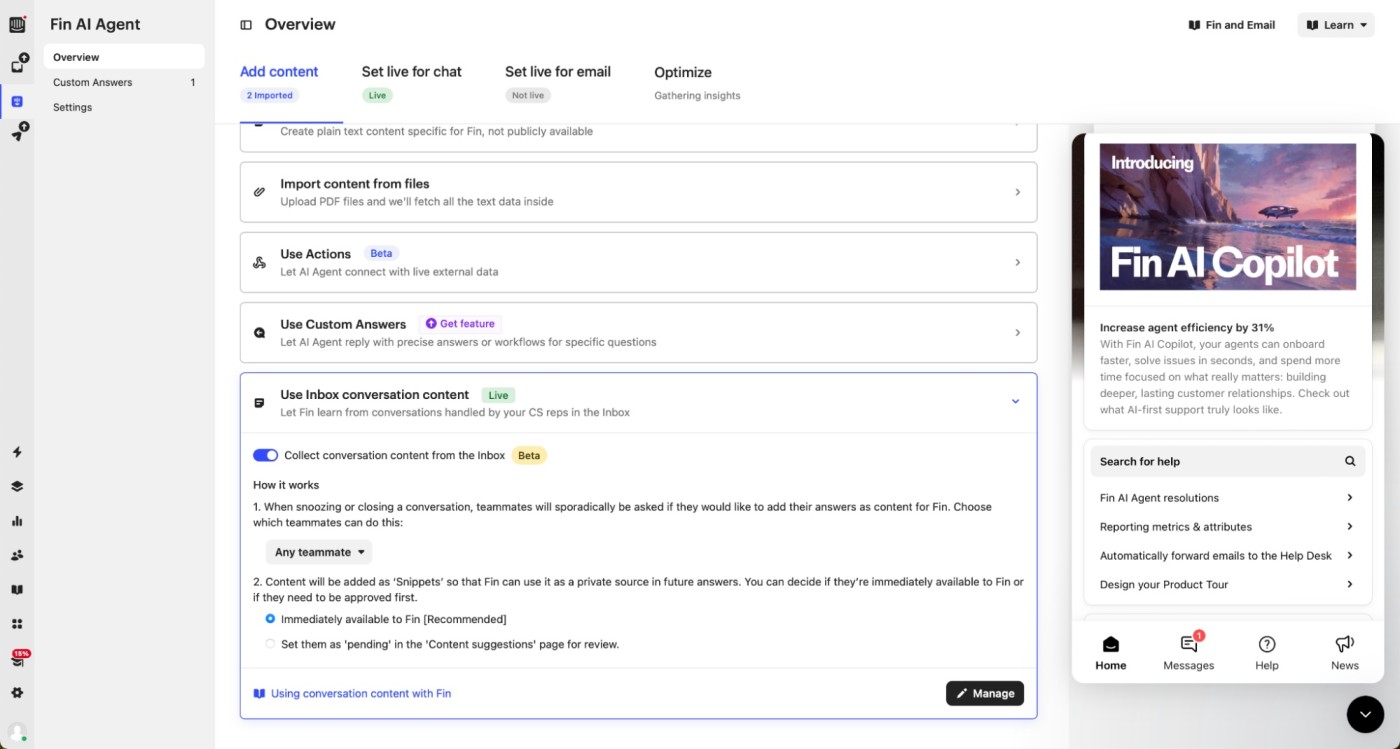
Intercom pros:
Intercom cons:
Intercom is one of the best help desk apps, and if you’re looking to use chatbots to handle customer support, it has a lot to like. Since Intercom is pretty feature-packed, Fin AI agent is the specific tool you’re looking for.
The chatbot builder can use your Intercom Help Center and customer conversations as a knowledge base, as well as your website, any content you upload, and other sources. And it works across live chat, email, SMS, WhatsApp, Facebook, and Instagram, though some channels are locked to more expensive plans or require a small fee. With all that, it’s surprisingly easy to use. If you’re looking for a premium chatbot-powered customer support platform, it’s well worth a look.
The monthly seat fee plus $0.99/resolution Fin AI Agent fee is expensive, yes, but it’s also transparent and flexible. And it’s not wildly out of line with what other premium apps charge—except many of them lock you into a few hundred dollars per month for 200 customer resolutions, rather than offering the more incremental price.
With that said, almost every help desk app now offers some kind of chatbot. If you’re happy with your chosen help desk and it already has all your customer data, it’s almost certainly not worth the hassle of switching to Intercom. If you’re starting from scratch, it’s my favorite—but remember, chatbots are fast becoming a feature, not a standalone product.
Intercom also integrates with Zapier so you can do things like automatically add leads to your CRM or email marketing app, send form responses to Intercom, and much more. Learn more about how to automate Intercom, or get started with one of these pre-made workflows.
Intercom pricing: From $39/seat/month plus $0.99/resolution with Fin AI Agent, but things can really go up from there.
How to build a chatbot using other apps
If none of the apps above are exactly what you’re looking for, there are other categories of apps that let you build a chatbot.
-
Before the sudden boom in AI chatbot builders, Manychat and Chatfuel were two of my favorite AI chatbot builders. They’re both currently deploying AI-powered features and options, but in my testing, things weren’t quite as good as the apps I selected for the list above. But if you want a more traditional chatbot builder with drag-and-drop options, logic flow, keyword recognition, and the like, Manychat and Chatfuel are still worth a try.
-
Again, building chatbots is increasingly more of a feature than something that warrants a dedicated tool. Your CRM and help desk software almost certainly have a chatbot builder option—and if they don’t, they will soon.
-
Similarly, the big three cloud hosting platforms, Google Cloud, Amazon Web Services, and Microsoft Azure, each have their own chatbot building tools. They were too technical to make this list, but if you’re building an app on their platforms, they’re worth considering.
Really, going forward, the question might not be which tool you should use to build a chatbot—but how you’ll get all your chatbots to talk to each other. (And the answer will probably be Zapier.)
Related reading:
This article was originally published in December 2019 by Marshall Gunnell and has also had contributions from Kaylee Moser. The most recent update was in August 2024.